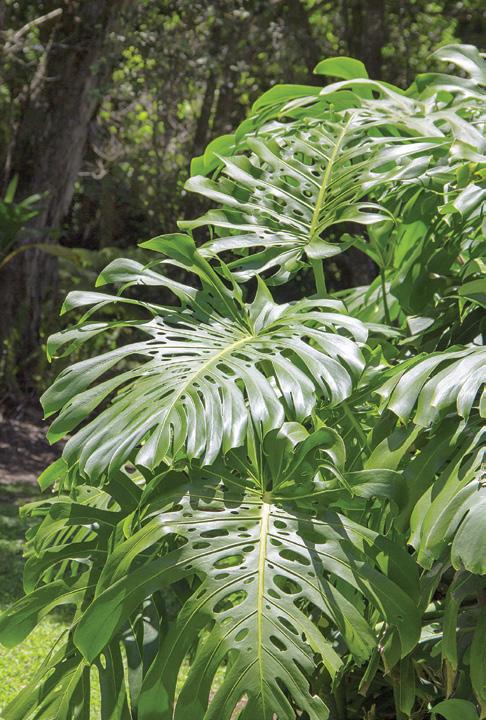
4 minute read
Tough houseplants that anyone can grow
By Dorothy Dobbie.
There is no such thing as a brown thumb, only busy people who don’t have time to fuss over the green things in their homes. So, to help you, we have compiled a list of a few plants that are never-miss. They can tolerate neglect and spring right back when you think they are on the brink of death and gratefully un-wilt, drop a sad leaf or two, but smile on you with perky leaves and even some blooms when you turn your attention to them for a moment.
Advertisement

Philodendron
Philodendron
Number one in my home is a plant that doesn’t look its thirty-some years. It has no drainage and has not been repotted for at least two decades. I am speaking of the pretty little philodendron in my bedroom. It is never fertilized and watered only occasionally when it looks very dry. If I neglect it too long, it will transform a leaf into yellow as a signal.
Philodendron hederaceum, also known as heartleaf philodendron, is a mildly vining plant, tumbling pleasingly out of its pot. Give it a haircut once in a while and put the cuttings in a glass of water. They will grow roots and can stay in that water as long as you like. Repotted, the cuttings can provide a gift for a lonely friend.
Philodendron has some important relatives that are almost as tough. Philodendron bipinnatifidum, a largeleafed variety will fill an empty corner that doesn’t get direct sunlight. On the other hand, Philodendron ‘Birkin’ is a cultivar much in the news these days as the new kid on the block. It is not easy care, needing lots of humidity, so if you don’t have a lot of time to devote to your plants, shun this shiny little striped beauty.

Pothos
Pothos
Philodendron is easy to confuse with pothos, Epipremnum aureum, (also called Devil’s ivy) another hardy, vining plant that has variegated markings of gold, white or yellow on its leaves. The leaves are narrower than those of the heart-shaped leaf of the philodendron, but larger, thicker, and
waxier. Philodendron leaves are also a darker green. Pothos tolerates even less light than philodendrons.
Both are easy to grow. My pothos is probably 20 years old and takes just as little care as the philodendron.

Peace lily.
Peace lily
Spathiphyllum is the formal name for the peace lily which hales from South America and didn’t come to the attention of the west until the late 1870s. But what a blessing this discovery was to plant-shy householders. Here is a tough but beautiful plant that needs the smallest amount of attention to bloom in gratitude. Neglect watering and it may wilt, but it will spring back right away when you get around to it. Let it dry out too long and it will turn some of its leaves brown, but it sheds them happily and puts out new ones with a little attention. If leaves turn yellow, chances are you are giving it too much water. It always enjoys a few periods of drought.
Peace lily doesn’t like the sun’s rays striking it directly, so give it an empty corner and a little extra light if you want it to bloom. As for the blooms, they look like white flags of peace, hence the name. The white is called a spathe, which protects the spadix, the spike of tiny flowers at the centre.
Propagation is through division. If you are determined to baby this plant, perhaps fill the watering can and leave it overnight. Although peace lily is pretty good at pulling gases such as benzene and formaldehyde from the air, it is a little sensitive to chlorine in city water.
These plants come in sizes small, medium, and large. ‘Petite’ is only 8 to 10 inches tall. ‘Mauna Loa’ which received the Award of Garden Merit at The Royal Horticultural show, is medium sized at 2 to 3 feet. ‘Sensation’ is 4 to 6 feet tall. ‘Nojo Lime’ has—you guessed it—lime leaves, and ‘Domino’, another medium, has variegated leaves.

Spider plant.
Spider plant
Indomitable might be the other name for spider plant, the intrepid and cheerful outreach plant.
So named for the spider-like plantlets the mother plant flings out, Chlorophytum comosum is one of the most popular houseplants there is. It too is indifferent about light, although more indirect light will lead to more plantlets and a happier, more exuberant plant.
Once again, fertilization is a luxury it seldom needs—too much of this treat can turn leaf tips brown. Water when the soil dries out. Let the water run through the pot and you have a happy plant.
There are both variegated and unvariegated varieties, although the pretty white and green leaves of the variegated type are a cheerful sight in the middle of winter. Propagation is simple. Just snip off one of the babies, called spiderettes, and set it on top of some moist soil.
Thank you, South Africa, for this gift to the plant-starved winter world.
All four of the above plants are good for the household air, cleaning up gasses and restoring oxygen. They are a perfect addition to the apartment or home.
Toxicity
Three of the four plants listed above are mildly toxic to pets, most causing mouth irritation, probably enough to keep your pet at bay.
Spider plants are listed as nontoxic to dogs and cats, although spider plants have a mild hallucinogenic effect on cats who can get diarrhea from ingesting the leaves. Hang a spider plant from the ceiling where it is out of reach if pets are a concern.










